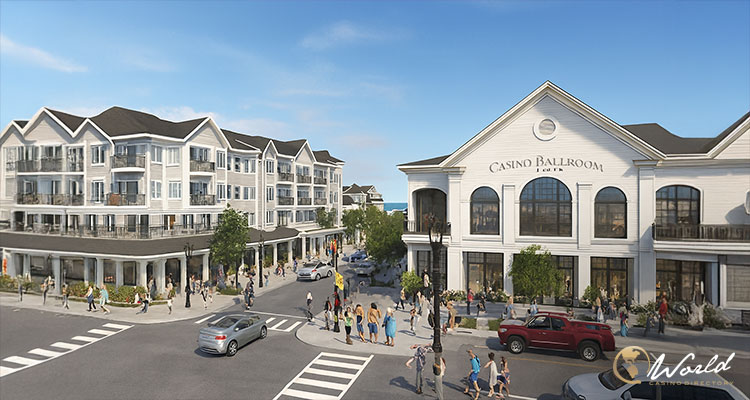Developers of the Hampton Beach Casino have unveiled an updated redevelopment proposal that trades earlier Miami-inspired architecture for a traditional New England look. The latest plans, presented to the Hampton Planning Board on Oct. 1 by owners Sal Lupoli and Fred Schaake, mark a significant step toward transforming one of New Hampshire’s most historic seaside destinations into a year-round hub for tourism and entertainment.
The ambitious project spans the block between F and D Streets, encompassing a 208-room hotel, 99 luxury condominiums, 38,500 square feet of retail and dining space, and a 52,000-square-foot charitable gaming casino. A 3,500-seat entertainment venue and a 732-space parking garage round out the plan.
Although the Planning Board continued the application to its Nov. 5 meeting for further review, this marks the developers’ first formal submission following earlier conceptual presentations. The Zoning Board has already granted variances for height, density, and the expansion of charitable gaming operations.
A Century-Old Landmark Poised for Renewal
Originally built in 1899, the Hampton Beach Casino has long been central to the local economy and culture. Its famed Ballroom, where icons like Led Zeppelin, U2, and The Doors once performed, has drawn visitors for generations. Schaake, quoted by Portsmouth Herald, reflected on its legacy, saying, “It was the place to be 100 years ago. How do we create something that lasts for the next generation for a century?”
Developers plan to preserve and display pieces of the Casino’s rich history. Lupoli hinted that artifacts found in the building’s basement could be turned into art installations, saying, “You’ll be shocked to see what’s in the basement, goes back 100 years. How do we turn it into art, maybe on the walls of this new facility?”
Renderings and animated visualizations presented to the board showcased the redesigned complex—complete with a new Ballroom and event space intended to host conventions and performances throughout the year.
A More “New England” Design
The updated design shifts from modern, angular forms to a tiered, “wedding cake” structure that fits the coastal character. Rick Friberg, president and CEO of TEC, described it as “much more New Englandy, and much less of the Art Deco, Miami thing.” Setbacks will create additional pedestrian space, aligning with efforts to make the beachfront more walkable and family-friendly.
Lupoli emphasized that the condominiums will be ultra-luxury units, each valued at around $1.1 million, and not primarily intended for short-term rentals. “These are not going to be regular condos,” he said. “We didn’t give it a lot of consideration of people buying something just to flip it or rent it.”
Economic Impact and Year-Round Growth
According to an economic report shared by State Representative Chris Muns, the redevelopment is expected to deliver profound economic benefits. The project will generate 1,700 construction jobs and contribute $168.4 million in additional economic activity during the building phase, while creating $8.7 million in new tax revenues. Once complete, it is projected to sustain 1,100 permanent jobs, spur $140.6 million in annual economic activity, and add $14.7 million in ongoing tax revenue.
The development would boost Hampton’s total property value by 8%, adding $311 million to its tax base. Town and school districts are expected to receive $3.65 million in additional property taxes annually. The developers also plan to contribute $3.7 million in one-time mitigation payments for infrastructure improvements, including traffic signals, pedestrian crossings, and wastewater studies.
Muns noted that the Casino Ballroom has always been central to Hampton Beach’s vitality: “The Ballroom is the engine that drives the economy at Hampton Beach, and the key to continued development is the redevelopment of the Ballroom complex.”
Next Steps for the Project
If approved, construction could begin as soon as 2026. Developers are also exploring the potential for a second phase north of D Street, possibly linked by a pedestrian bridge. Future expansion could add more residential units if market demand supports it.
Community leaders, including Selectman Chuck Rage, have expressed support for the plan, calling it “the latest in a series of improvements that have helped Hampton grow in recent years.”
As Representative Muns summarized, the project represents a rare opportunity to rejuvenate one of New Hampshire’s most beloved landmarks. “Let’s push the ball over the goal line and make this once-in-a-lifetime opportunity to jumpstart the continued redevelopment of Hampton Beach a reality.”


